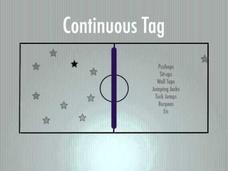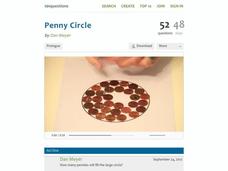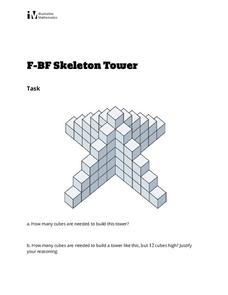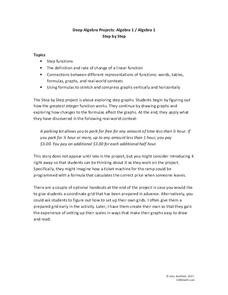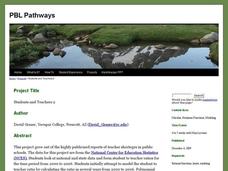Illustrative Mathematics
Introduction to Linear Functions
Introduce your algebra learners to linear and quadratic functions. Learners compare the differences and relate them back to the equations and graphs. Lead your class to discussions on the properties of a function or a constant slope...
Illustrative Mathematics
Modeling with a Linear Function
Here is a well-designed resource that provides five yes-or-no questions which model different situations with linear functions. It makes a good pre-test for the beginning of the unit. The purpose is to elicit common misconceptions of...
PBL Pathways
Medical Insurance 3
Create a technical report explaining the components of a medical plan through a function. The project-based learning activity gives a medical insurance scenario that young mathematicians model using piecewise functions. Their analyses...
Curated OER
Unstable Table
Bothered by a wobbly table? Learn how to fix this problem using concepts of slope and continuity. Pupils first consider the problem in two dimensions and then progress to three dimensions. The solution is really quite simple.
PhysEdGames
Continuous Tag
Assign a tagger, and everyone else as runners. The tagger will tag people at random. Persons tagged must go to the other side of the gym court to perform a skill. Once they are done, they can go back in the game.
101 Questions
Penny Circle
Watch as your classes buy into a rich lesson full of information. A video opener challenges individuals to determine the number of pennies that fit in a circle with a 22-inch diameter. Using lesson materials, scholars collect data and...
Curated OER
Using Function Notation II
Learners write an example to show a function statement true and another to show it false in this short task that addresses some common student misconceptions.
Curated OER
Rumors
Your young gossipers write an exponential function for the number of people who have heard a rumor after a number of days have passed. Learners then answer a series of questions, including whether or not the solutions are realistic by...
Curated OER
Comparing Exponentials
Growing money exponentially is the context of this scenario that asks learners to compare investments in two certificate of deposit accounts. Your young investment analysts will learn about the exponential characteristics of money...
Curated OER
Skeleton Tower
Your algebra learners build a quadratic function in this task of counting the blocks used to build objects. The arithmetic sequence that shows up brings up a shortcut to the long addition using the Gauss Method. Eventually, learners...
5280 Math
Step by Step
One step at a time! A seemingly linear relationship becomes an entirely new type of function. Young scholars build their understanding of step functions by completing a three-stage activity that incorporates multiple representations of...
Noyce Foundation
Digging Dinosaurs
Build a function to solve problems rooted in archeology. A comprehensive set of five lessons presents problems requiring individuals to use functions. The initial lesson asks learners to find the possible number of dinosaurs from a...
PhysEdGames
Mat Tag
Choose two people to be taggers and give them each a dodgeball. Spread out the four mats in the shape of a diamond baseball on the gym floor. Assign an equal number of players to each mat. When signaled, runners run continuously to...
PhysEdGames
Fresher
Split the class in half. Set up two cones on opposite ends of the gym, using the gym lines as boundaries. These are the jails. The object of the game is to tag another player that is "older" (not in age) than another. The "fresher" a...
Brandenburg Studies
The Timeline Project
This is a great idea for any social studies classroom to incorporate throughout the year as an ongoing project! Line your walls with a continuous strip of butcher paper to design a large timeline that you can add to as you cover...
Saint Louis Zoo
Introduction to Natural Selection: Darwin & Lamarck
Charles Darwin and Jean Baptiste Lamarck are credited for developing the theory of natural selection. After teaching your beginning biologists about acquired characteristics, they read the included selection and answer questions that...
PBL Pathways
Students and Teachers 2
Examine trends in student-to-teacher ratios over time. Building from the first task in the two-part series, classes now explore the pattern of student-to-teacher ratios using a non-linear function. After trying to connect the pattern to...
101 Questions
Deodorant
Smells like learning! Young scholars collect data on the length of time a stick of deodorant lasts. After modeling the data with a graph and function, they make predictions about deodorant use over time.
101 Questions
Blob Jump
For every action, there is an equal and opposite reaction. In the case of the blob, that reaction is a trip several feet in the air! Learners begin by watching the world-record blob jump. They then analyze the flight of the person using...
Curated OER
Exponential Growth versus Linear Growth II
Your algebra learners discover that exponential functions, with a base larger than one, outgrow linear functions when the inputs increase sufficiently. Their analysis includes using a graphing calculator to produce tables.
Curated OER
Grammar Games and Activities
Thirty pages of grammar activities? Your young grammarians will be well versed in the parts of speech, basic verb tenses, and much more after completing even a handful of these exercises.
Howard Hughes Medical Institute
Classroom Activities: Mirror-Tracing Activity
What does it take to train your brain? Learners explore the question as they experiment with their own memory and motor skills. They attempt to trace an object using a mirror and then score their results over several trials. They then...
English With Jennifer
Conversation Pieces: A Verb Tense Activity
Teach your English language learners about conversations by inviting them to participate in a conversation about an interesting object. Through this conversation, learners will naturally use various verb tenses and practice asking...
Forest Foundation
The Nature of Trees
Young botanists examine the different parts of tress and then draw parallels between the functions of these parts and the function of parts of the human body.




